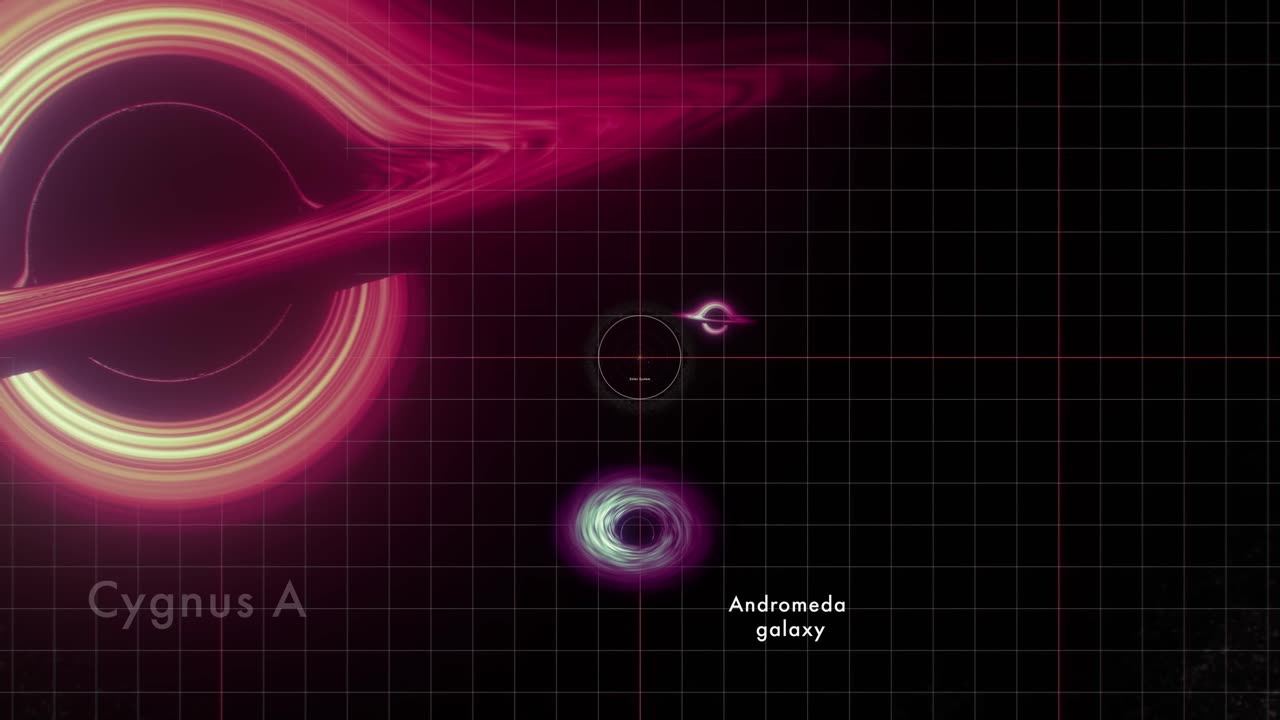Premium Only Content

NASA Animation Sizes Up the Biggest Black Holes
Editor's Note: A previous version of this video mislabeled the orbit of Saturn as the orbit of Jupiter.
This new NASA animation highlights the "super" in supermassive black holes. These monsters lurk in the centers of most big galaxies, including our own Milky Way, and contain between 100,000 and tens of billions of times more mass than our Sun,
Any light crossing the event horizon - the black hole's point of no retum - becomes trapped forever, and any light passing close to it is redirected by the black hole's intense gravity. Together, these effects produce a "shadow" about twice the size of the black hole's actual event horizon.
The animation shows 10 supersized black holes that occupy center stage in their host galaxies, including the Milky Way and M87, scaled by the sizes of their shadows Starting near the Sun, the camera steadily pulls back to compare ever-larger black holes to different structures in our solar system
First up is 1601+3113, a dwarf galaxy hosting a black hole packed with the mass of 100,000 Suns. The matter is so compressed that even the black hole's shadow is smaller than our Sun.
The black hole at the heart of our own galaxy, called Sagittarius A* (pronounced ay-star), boasts the weight of 4.3 million Suns based on long-term tracking of stars in orbit around it. It's shadow diameter spans about half that of Mercury's orbit in our solar system.
The animation shows two monster black holes in the galaxy known as NGC 7727. Located about 1,600 light-years apart, one weighs 6 million solar masses and the other more than 150 million Suns, Astronomers say the pair will merge within the next 250 million years.
At the animation's larger scale lies M87's black hole, now with a updated mass of 5.4 billion Suns. Its shadow is so big that even a beam of light-traveling at 670 million mph (1 billion kph) - would take about two and a half days to cross it.
The movie ends with TON 618, one of a handful of extremely distant and massive black holes for which astronomers have direct measurements. This behemoth contains more than 60 billion solar masses, and it boasts a shadow so large that a beam of light would take weeks to traverse it.
Music credit: "In the Stars' from Universal Production Music
Credit: NASA's Goddard Space Flight Center Conceptual Image
Lab
Lead Producer: Scott Wiessinger (KBRwyle) Lead Animator: Krystofer Kim (KBRwyle) Lead Science writer: Francis Reddy (University of Maryland
College Park) Visualizer: Jeremy Schnittman (NASA/GSFC)
Producer: Sophia Roberts (AIMM)
Scientist Jeremy Schnittman (NASA/GSFC)
-
 55:49
55:49
SGT Report
13 hours agoFAKED TRAGEDY, LONE GUNMAN OR PATSY? -- Jeffrey Prather
15.2K79 -
 9:30
9:30
Adam Does Movies
12 hours ago $0.04 earnedThe Long Walk - Movie Review
305 -
 2:28
2:28
WildCreatures
14 days ago $0.30 earnedNature's struggle for survival: Water snake devours mudpuppy
1.83K2 -
 1:07
1:07
Memology 101
13 hours ago $0.03 earnedEric Swallowswell compares January 6th to 9/11 and Pearl Harbor
72712 -
 24:21
24:21
Uncommon Sense In Current Times
18 hours ago $9.68 earnedA Revolution of Virtue | Charlie Kirk on Beating the Woke, Faith & Saving the West
24.5K27 -
 33:17
33:17
Homesteading Family
3 hours agoThe End of The Pantry Chat
17.6K8 -
 18:42
18:42
Nicholas Bowling
16 hours ago $4.52 earnedCharlie Kirk Martyred – A Christian's Response
22K34 -
 11:34
11:34
The Kevin Trudeau Show Limitless
3 days agoClassified File 4 | The Hidden Science of Brain Control REVEALED!
60.8K15 -
 2:17:41
2:17:41
Side Scrollers Podcast
1 day agoCharlie Kirk’s Assassin in Custody + Asmongold Declares War + More | Side Scrollers
45K99 -
 33:32
33:32
ZeeeMedia
1 day agoKidnapping Cover-Up, Unvaxxed Kids Healthier, EU's New World War | Daily Pulse Ep 105
38.6K33